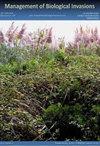Mussel squeeze: dissolved oxygen and temperature can “squeeze” zebra mussels out of invaded reservoirs
IF 1.2
4区 环境科学与生态学
Q3 BIODIVERSITY CONSERVATION
引用次数: 0
Abstract
Zebra mussels ( Dreissena polymorpha ) are an aquatic invasive species that cause extensive economic and ecological impacts and are a management priority in areas outside of their native range. Survivorship and distribution of zebra mussels within a waterbody are thought to be influenced by temperature and dissolved oxygen conditions, but detailed information to confirm the importance of these environmental controls is necessary to inform management efforts. We measured planktonic zebra mussel veliger density and adult survivorship in San Justo Reservoir in central California to determine distribution and timing of spawning in relation to temperature and dissolved oxygen throughout winter, spring, and summer. We found seasonal patterns in adult survivorship, with high mortality late in the summer and higher than expected survivorship during the spring when dissolved oxygen concentrations were approximately 1 mg/L. Veliger abundance peaked several meters above the thermocline from June to August. Dissolved oxygen concentrations limited veliger distribution, with few to no veligers collected in the anoxic hypolimnion. Veliger settlement out of the water column appears to be possible in San Justo Reservoir at any time of year. A better understanding of how veligers, juveniles, and adult mussels respond to fluctuating dissolved oxygen and temperature conditions will further knowledge of timing and duration of water drawdowns or other control methods for managing this harmful invasive species贻贝挤压:溶解氧和温度可以将斑马贻贝从入侵的水库中“挤压”出来
斑马贻贝(Dreissena polymorpha)是一种水生入侵物种,具有广泛的经济和生态影响,是其原生范围以外地区的管理重点。斑马贻贝在水体中的生存和分布被认为受到温度和溶解氧条件的影响,但确认这些环境控制的重要性的详细信息是必要的,以便为管理工作提供信息。我们测量了加利福尼亚中部圣胡斯托水库浮游斑马贻贝的密度和成虫存活率,以确定其产卵分布和产卵时间与冬季、春季和夏季温度和溶解氧的关系。我们发现了成虫存活率的季节性模式,夏末死亡率高,春季溶解氧浓度约为1 mg/L时存活率高于预期。从6月到8月,威利格丰度在温跃层以上几米处达到峰值。溶解氧浓度限制了细菌的分布,在缺氧低磷环境中几乎没有收集到细菌。在一年中的任何时候,圣胡斯托水库的水柱外似乎都有可能出现Veliger沉降。更好地了解贻贝、幼贻贝和成年贻贝如何对波动的溶解氧和温度条件做出反应,将进一步了解水下降的时间和持续时间,或管理这种有害入侵物种的其他控制方法。
本文章由计算机程序翻译,如有差异,请以英文原文为准。
求助全文
约1分钟内获得全文
求助全文
来源期刊

Management of Biological Invasions
Agricultural and Biological Sciences-Ecology, Evolution, Behavior and Systematics
CiteScore
3.40
自引率
6.70%
发文量
21
审稿时长
16 weeks
期刊介绍:
Management of Biological Invasions, established in 2010 by Dr. Elias Dana, is an open access, peer-reviewed international journal focusing on applied research in biological invasions in aquatic and terrestrial ecosystems from around the world. This journal is devoted to bridging the gap between scientific research and the use of science in decision-making, regulation and management in the area of invasive species introduction and biodiversity conservation.
Managing biological invasions is a crisis science, with Management of Biological Invasions aiming to provide insights to the issues, to document new forms of detection, measurements and analysis, and to document tangible solutions to this problem.
In addition to original research on applied issues, Management of Biological Invasions publishes technical reports on new management technologies of invasive species and also the proceedings of relevant international meetings. As a platform to encourage informed discussion on matters of national and international importance, we publish viewpoint papers that highlight emerging issues, showcase initiatives, and present opinions of leading researchers.
 求助内容:
求助内容: 应助结果提醒方式:
应助结果提醒方式:


